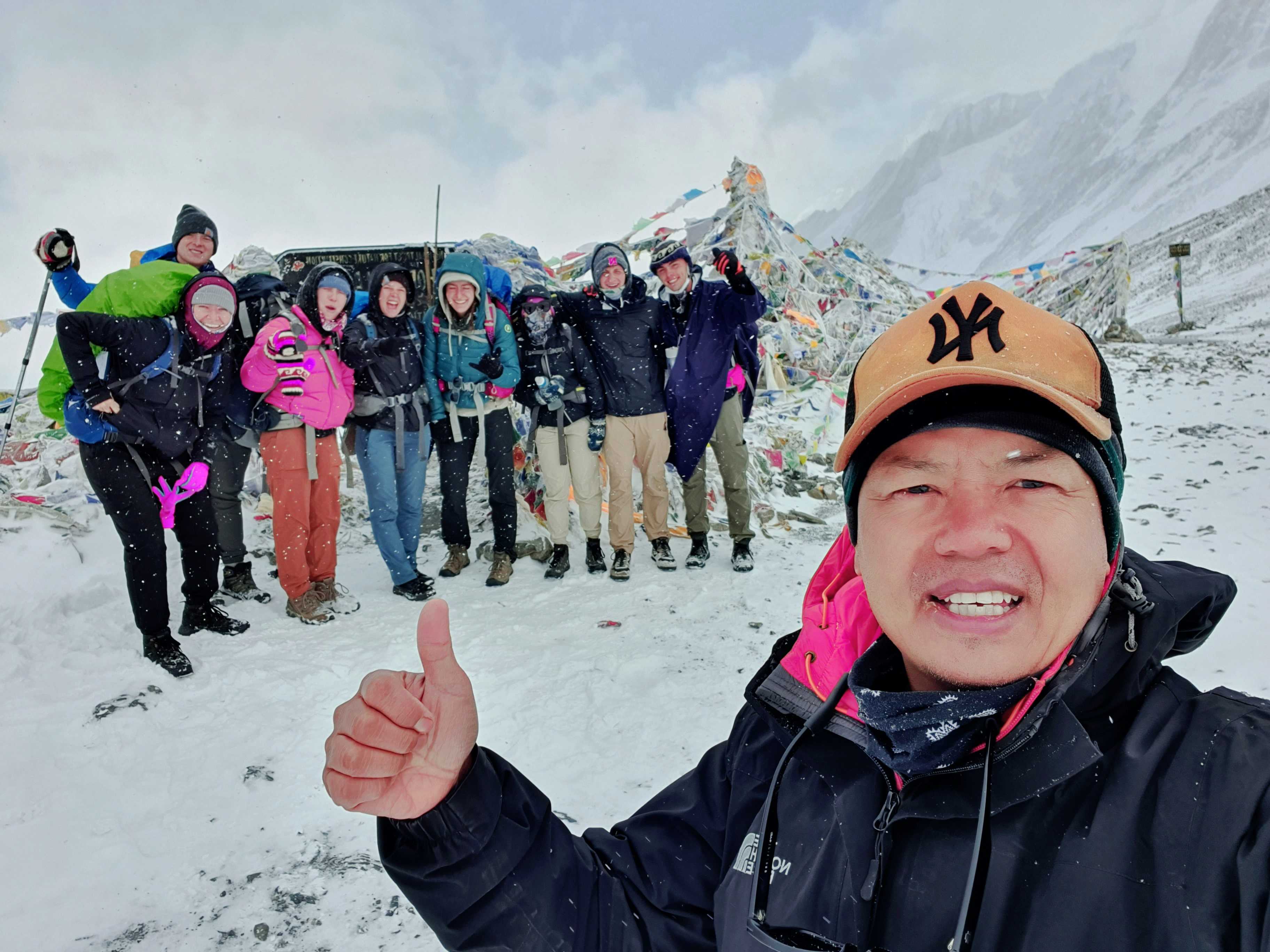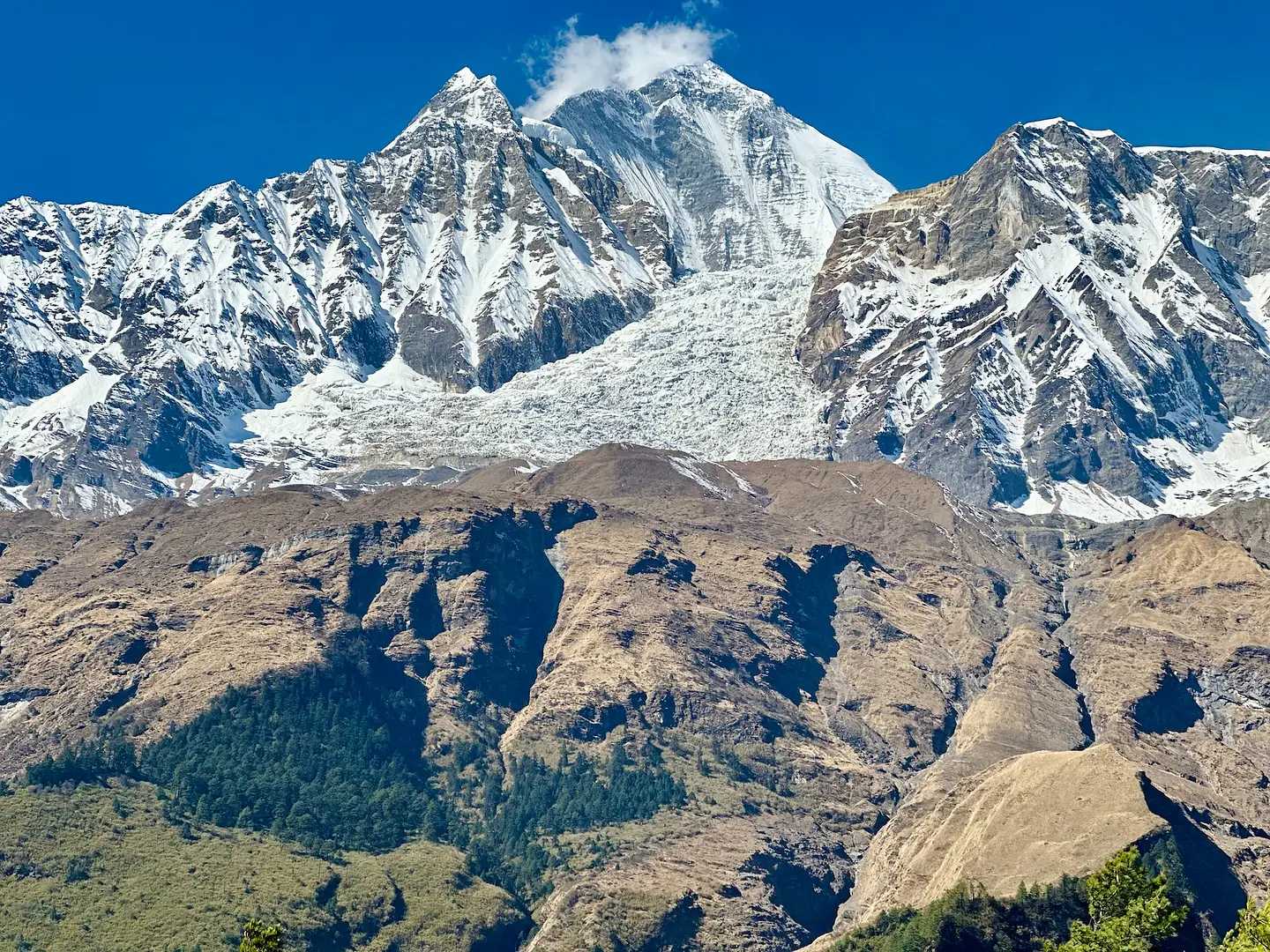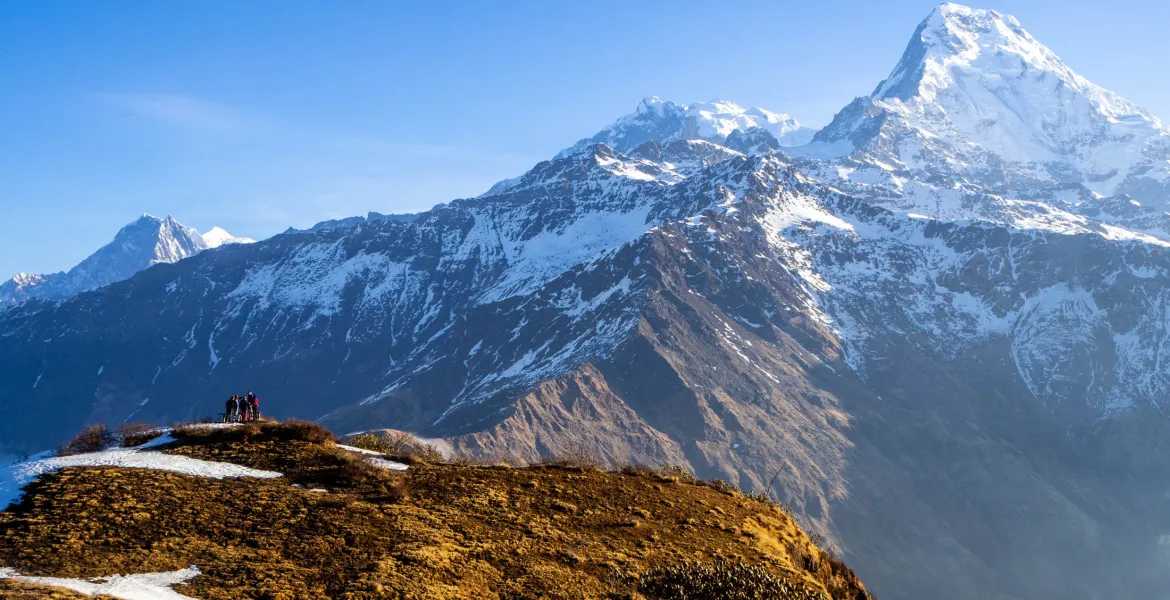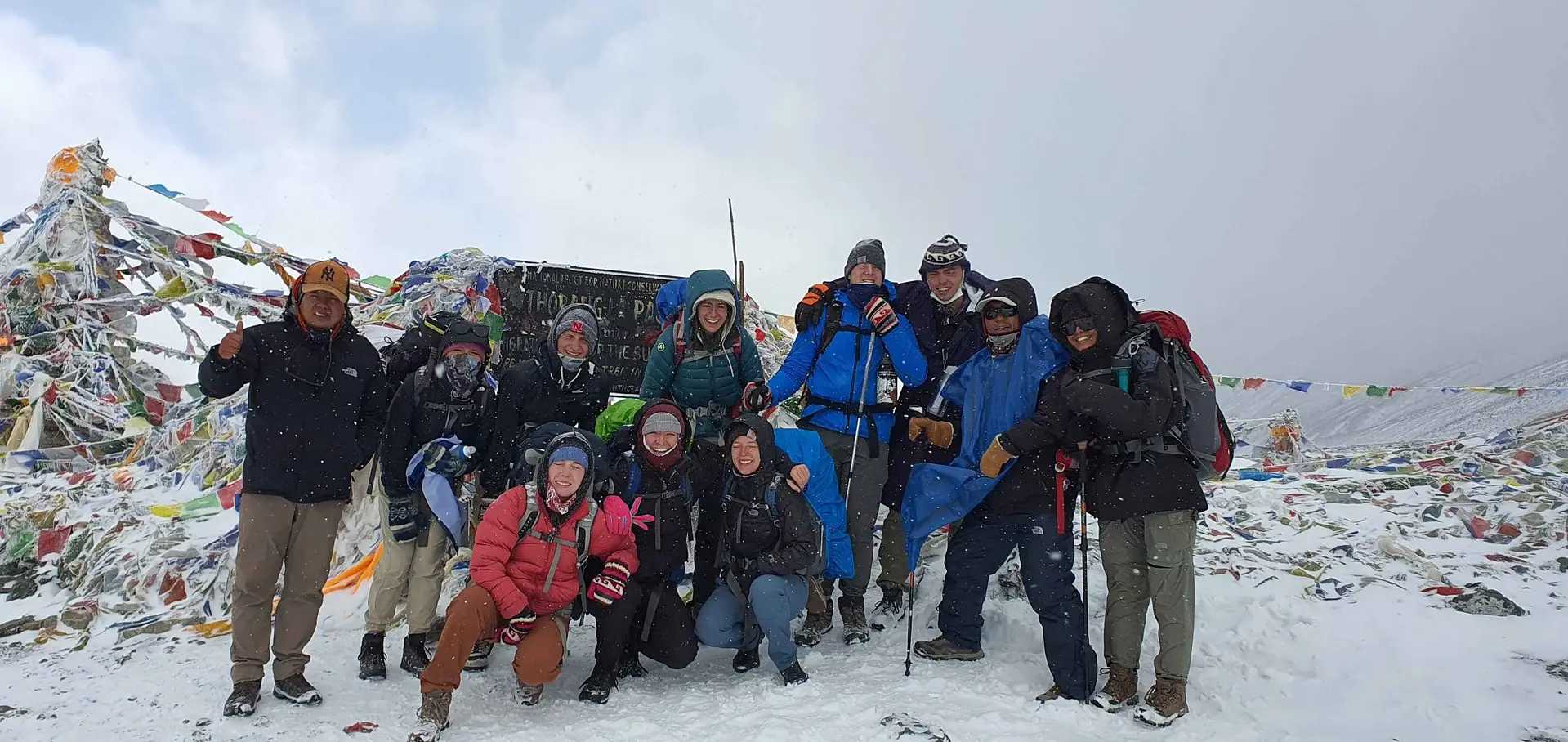Everest Three Pass Trek
Share:
Good to know
Duration18 days
Difficultychallenging
Max Altitude5,600 m
Group Size1 +
Trip StartsKathmandu
Trip EndsKathmandu
Group StyleGroup and Private
ActivitiesTrekking
Best SeasonMar-May & Sept-Dec
Highlights
Cross three challenging high passes for an ultimate adventure.
Breathtaking views of Everest, Lhotse, Makalu, Cho oyu, and more.
Visit the Everest Base Camp and witness its grandeur.
Explore Gokyo Lakes, a mesmerizing set of turquoise glacial lakes.
Discover ancient monasteries, including Tengboche Monastery.
Immerse in Sherpa culture and hospitality in quaint villages.
Witness sunrise from Gokyo Ri, offering a 360-degree panorama.
Create memories of a lifetime in the lap of the Himalayas.
Overview about Everest Three Pass Trek
Spanning approximately 18 days, the Everest Three Pass Trek starts and ends in Lukla, leading adventurers through the captivating landscapes of the Khumbu region. Cross the Kongma La Pass, Cho La Pass, and Renjo La Pass, each offering unique challenges and breathtaking panoramas. The trek combines the iconic Everest Base Camp and Gokyo Valley, ensuring a comprehensive exploration of the region. Traverse through Sherpa villages, ancient monasteries, and stunning glacial lakes, creating memories that last a lifetime.
Itinerary
Day 0: Airport/Tourist bus park
Airport picks up on arrival and transfers to hotel. On arrival at the hotel, short arrival info and trip plan.
Day 1: Kathmandu to Lukla (2,840m) and trek to Phakding village (2610m) 3 and half hrs, lunch camp
An early morning flight to Lukla airport (2,840m) with amazing views of mountain and beautiful landscapes takes us to gateway to Everest Base Camp and the land of Sherpas. Our trek heads through the village of Lukla, descending to along the east bank of the Dudh Kosi river, by a gentle hike and level meandering walk to Phakding village.
Day 2: Phakding to Namche Bazaar (3,440m) 6 hrs, including lunch break.
After breakfast trek along the bank of Dudh Kosi, the trail goes through rhododendron forest and pine trees to Jorsalle village. Shortly after completing check post formalities we cross the Dudh Kosi via suspension bridge to start a gradual up hill to Namche Bazaar, (Sherpa Capital). We encounter our first sight of Everest and Lhotse, great view of the mountains across the valley.
Day 3: Namche Bazaar, for acclimatization, 4 hrs hike.
To allow us to adjust to the high altitude. Explore the local market, observe the local culture, hike up to the Everest viewpoint or simply relax. Time is available to make an excursion to either the village of Syangboche (3,720m). At Syangboche is where the worlds highest airstrip is located and to the west stands Mount Kongde. The trail here is a steep ascent along small pine trees and juniper shrubs, and route looms Khumbi Yul Lah.
Later descent down to lodge and relax.
Day 4: Namche Bazaar to Tengboche (3,860m) 5 and half hrs, including lunch break.
The trail ascends out of the village and flat path along the valley with great views of Everest, Nuptse and Lhotse. There is a steep descent taking us through a forest towards the bridge over the Dudh Kosi. After crossing the river we hike up zigzagging path through a rhododendron forest where we may encounter both musk deer, mountain goats and wild colourful Pheasants(national bird) when we approach Tyangboche, which opens up to breath taking views of Everest, Nuptse, Ama Dablam and Taboche peaks. Tyangboche, famous for its legendary monastery, it is the largest in Khumbu area. There is time to visit both the monastery and museum.
Day 5: Tengboche to Dingboche(4,410m) 6 hrs, including lunch break.
The day commences with a gradual hike through meadows and a pine forest towards a small bridge over the Imja river, and then a climb to Dingboche with spectacular views of Ama Dablam. In the route we pass through Pangboche the home of the most ancient monastery in the region and the Gompa which houses the famous Yeti scalp.
Day 6: Dingboche, for acclimatization, hike up to Nagarjun Ri(5,325m) 4 hrs.
Today is second acclimatization day. You can either explore the village and surrounding area or relax and enjoy the best views. There is an option to take a guided excursion to explore the Imaj river valley with a hike to Nagarjun Ri. Within hour of leaving the village along a black rocky trail there are magnificent close views of Makalu and Lhotse, Island peak, Ama Dablam,etc.. Retracing our steps we return to the village(Lodge).
Day 7: Dingboche to Chhukung(4,730m) 2 hrs, lunch camp.
After breakfast we head to the trail ascending along a rocky path to Chhukung. After lunch and resting we head up to Chhukung Ri(5,550m)view point. Immediately we are captivated by Lhotse, the fourth highest peak in the world, the closeness makes it incredibly inspiring, the amazing views of Ama Dablam, Island Peak and Thamserku. Although the mountain views are the same as those from Chhukung, on the summit the mountains are more commanding with their extraordinary views.
Day 8: Chhukung to Labuche(4,910m) via Kongma La pass(5,535m), 9 hrs, including pack lunch.
Wake up early in the morning, have breakfast and start the trek to first pass Kongma La. Today should not be underestimated, it is a challenging pass. As we take a side valley towards the pass the first part of the trail is fairly level before a short steep ascent, on a narrow path, takes between 4 and 5 hours that brings us to the pass’s summit. As we ascend we see the same great scenery as on Chhukung Ri. The top of the pass is adorned with prayer flags and from east to west we have a breathtaking view of peaks and glaciers including Lobuche East and West. The trail descends steeply away from the pass bringing us to the Khumbu glacier, which we cross, negotiating our way through the moraines to reach the pastures of Labuche. Sunset on Nuptse ends our first pass perfectly.
Day 9: Labuche to Gorakshep(5,140m) EBC(5,364m), 8 hrs including lunch break.
An early start to a challenging day to accomplish our dream that is EBC. The route commences with a gentle ascent as we continue along the side of the Khumbu Glacier, which becomes rocky and awkward for a short time. Rewarded with breathtaking views, of Pumo Ri (7,165m) lies directly ahead, on the right Nuptse (7,861m) sight of Everest (8,848m). A descent brings us to Gorakshep (5,140m) where we lunch and rest before taking the trail to Everest Base Camp.After exploring Base Camp and we return to Gorakshep for a well-deserved rest.
Day 10: Ascend to Kalapatthar(5,550m) and trek down to Dzongla village(4,830m) 8 hrs, including lunch break.
Breathtaking scenery today is the highlight. It is another early morning start to see dawn break and capture this amazing daily event as Everest and surrounding peaks reveal themselves. An intricate ascending route threads its way through crevasses and over moraine ridges. At Kala Pathar’s summit (5,550m) there is an unforgettable panorama view of Ama Dablam, Makalu, Nuptse, Lhotse and the impressive black pyramid of Everest. When it is time to leave with our indelible memory of all that is before us we retrace our steps to Gorakshep and trek continues down to our destination via Lobuche passing a number of streams pastures of Dzongla, a small village that situated at the bottom of Cholatse (6,335m).
Day 11: Dzongla to Thagnag village(4,700m) via Cho-la pass(5,330m) 8 hrs, including pack lunch.
Wake up early in the morning have breakfast and start the trek over the Cho La (5,330m) pass; with amazing wilderness between Dzongla and today’s resting place, we depart with a packed lunch. The trail is well defined as we leave the grazing pastures behind and start our ascent to the pass. Crossing a small glacier, which is usually covered in snow, is reasonably straightforward as we continue our hike to Cho La’s summit. From here and there are great views with different aspects of the mountains seen before. A steep descent is made to Thagnag, a small Sherpa hamlet, taking us along a moraine and rock trail and through a boulder field.
Day 12: Thagnag to Gokyo lake(4,790m) 3 hrs, lunch camp.
After the breakfast the trail takes us along the eastern side of Gokyo Valley. Shortly we will be crossing the Nagozumba Glacier, which is well marked with cairns. At the top of the moraine overlooking the Nagozumba Glacier we climb down beside a tributary which leads us to the beautiful turquoise waters of the Gokyo Lake where Gokyo village, a small settlement, lies on its shores. Rest of the day is free for you to explore the village and lakes.
Day 13: Gokyo Rest day, hike up to Gokyo Ri view point(5,355m) 4 hrs.
Special day: After breakfast we start early this morning to ascend Gokyo Ri view point, a small peak above Gokyo village and lakes. The views on the way up are fantastic, it offers you the 360º view at the summit. It is one of the best views in the world, and some would say the best in Nepal. In front of you are Everest, Lhotse, Makalu and Cho-Oyu etc.. also from the lake we will have a close up view of the sixth highest mountain in the world Mount Cho Oyu at 8,188m. Retracing our steps we return to the Lodge and relax at the village.
Day 14: Gokyo to Lungden(4,368m) via Rinjo la pass(5,360m) 8 hrs, including pack lunch.
Another special day, today we complete our final pass, Renjo La at 5360m, at taking a step back in time as our trail leads us along a wilderness caravan route and several very old Sherpa villages. As we leave the village of Gokyo the trail takes us up a gentle grassy slope, which quickly becomes a steep zigzag uphill, The highlight of the day is the reward at the top, as you step on the pass the stunning outlook unfolds: Everest, Kangchung, Lhotse, Makalu and the Gokyo lakes to the east, while the west offers Tengi Ragi Tau, Rolwaling Himal and the small lakes, which we pass on our descent to Legden village.
Day 15: Lungden to Thame village(3,820m) 6 hrs, including lunch break.
The trail is much easier than previous days. It takes us along an old Tibetan Himalayan trade route following the Bhote Kosi river and ending at the village of Thame, our destination. The landscape becomes a forest of first, with juniper cladding the hillside. Thame is the oldest Sherpa village in the Everest region, and the birthplace of Tenzing Norgay Sherpa, who summited Mt. Everest with Sir Edmund Hillary.Thame Monastery is one of the oldest in the region and its worth to visit.
Day 16: Thame to Phakding (2,610m) via Namche Bazaar 7 hrs, including lunch break.
We retrace the way through the rhododendron and pine forest to the valley. We follow the Dudh Koshi river downhill on our way back to Phakding via beautiful villages.
Day 17: Phakding to Lukla (2,840m) 3 and half hrs.
Now it’s time to recall our moment. The day we started with all the hopes and excitement. Finally, we are at Lukla again, completing our journey to 3 pass 3 peaks. Enjoy the Sherpa hospitality.
Day 18: Lukla to Kathmandu by flight, 30 minutes.
We take the great flight to Kathmandu: hotel transfer and free day.
Not satisfied with regular itinerary?
Customize your own
Inclusions
What‘s included
What‘s excluded
Essential Info
Suggested Equipment List
Duffel/Rucksack bag
Walking Pole
Day pack.
Trekking shoes.
Sports shoes or sandals.
Sun Hat/cap
Warm woolen cap.
Warm fleece jacket or puffy jacket
Waterproof Gore-Tex layer
Pullover or warm sweeter
Raincoat
4/5 pairs of good quality socks
Hand gloves.
2/3 pairs of trekking trousers.
3/4 pairs of trekking shirts.
3/4 pairs of underwear (non cotton preferred).
Sun glasses
Water bottle
4 season sleeping bag
Flash or Torch light
Camera and batteries
FAQs
Q1. How challenging is the Everest Three Pass Trek?
The trek is challenging due to high altitudes and multiple mountain passes. Prior trekking experience and good physical fitness are recommended.
Q2. What's the best time to undertake this trek?
Spring (March to May) and Fall (September to November) are the best seasons, offering clear skies and favorable weather.
Q3. Is altitude sickness a concern on this trek?
Yes, altitude sickness is a potential risk. Acclimatization days and proper hydration are crucial to minimize its effects.
Q4. Are there accommodations along the route?
Yes, teahouses and lodges are available in most villages, providing basic amenities. Accommodations may get simpler at higher altitudes.
Q5. Do I need special permits for this trek?
Yes, you’ll need permits like the Sagarmatha National Park Permit and the Khumbu Gaunpalika Permit.
Q6. Is previous trekking experience necessary?
While not mandatory, previous trekking experience will certainly help you cope with the physical demands and altitude challenges.
Q7. What should I pack for the trek?
Pack essentials like warm clothing, comfortable trekking shoes, a sleeping bag, trekking poles, and personal medications.
Other Trips You May Like




Quick Inquiry



















